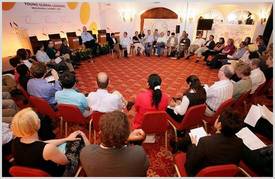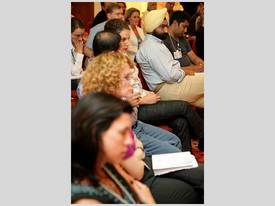At the recently concluded inaugural summit of the Forum of Young Global Leaders, a sister organization to with the World Economic Forum, in Zermatt, Switzerland, George A. Kern, chief executive officer for International Watch Company (IWC) Schaffhausen, Switzerland, and a YGL member, told me something really profound, and really simple. He said, “you know, what is really amazing here is that two days ago they (YGL organizers) threw together more than 100 leaders from different continents, different ethnicities, different cultures, different geographic locations, and even different religions, and a mere 48 hours later we are all, for the most part, on the same page with respect to the major values we must have, and what we must collectively do, to solve some of the world’s worse and most troubling conflicts and problems. And so I was thinking, …why can’t the rest of the world do this?” Great quote George, my friend, and an excellent question for our world leaders of today. To quote a well known saying of the time, “why can’t we all get along?”
Well, another thing became altogether as clear to me on a global basis there in the hills and valleys of picturesque Zermatt, as it has always been clear to me locally, and even nationally for me here in the United States; diversity is not a goody-goody issue, diversity is a business issue. Always has been. Or as we like to say at Operation HOPE, “doing well and doing good, and ultimately doing well by doing good.” These things are not mutually exclusive, nor impossible. And neither are they new ideas either. 
From the founding of our great country and the civil war, diversity has always been a business issue. Let’s be very clear; no one went to war to save, well, me (as representative of all black Americans in this analogy). I am very sure that slavery was indeed a strong and compelling moral issue for some, including President Abraham Lincoln, but it was not the primary reason we went to war.
At the end of the day, we went to war because the south and all of its economic interests, were stuck in an agricultural age, with “free labor” (I am sure it will come to you shortly what I meant here…), and the north had diversified, literally. Not only had the north moved quickly into the industrial age, inclusive of banking, finance, import/export and manufacturing amongst other progressive industries (every nation goes through four primary economic models – the agricultural age, the industrial age, the technology age and the information age), and at the same time became a universal welcome mat for immigrants of the day; Italians, the Irish and a range of other “struggling” Europeans that came to America looking for a better tomorrow.
In short, the civil war started because the south was resisting northing economic domination, plain and simple. But the northern states did not need war, the threat of conflict or protectionism because it had open markets and diversity on its side; the north was invested in the open hand of the future, while the south was holding on to the closed fist of the past. Plain and simple. Diversity has always been a business strength.
And then you have America of 2005, as the most compelling model ever; a nation, America, which is literally the largest and most prosperous economy in the world today, is also the most ethnically diverse. That’s right, America is the only nation in the world with every race of people within its borders! You cannot do business with people you don’t reflect, respect, or understand. Think diversity is a business issue? You bet.
But the ironies don’t end there, for the two largest economies within the United States of America are California and New York, and the two most ethnically diverse states in America, ….are California, and New York. You cannot do business with people you don’t reflect, respect or understand.
And where is the 5th or 6th largest economy in the world today? California. Home to 34 million people and an overwhelming majority of ethnic minorities, including our Hispanic friends that so many seem to have a problem with. A few years back I read a statistic that 8 out of 10 surnames in California on mortgage applications were Hispanic surnames. Huh? That’s right — and real estate is not exactly a minor tool in our current economic prosperity tool box, I might add. And let me add this interesting fact as well – for years the largest condiment seller in the nation was ketchup, and it’s now salsa — go figure. Yes, times are changing, and you cannot do business with folks you don’t reflect, respect or understand. It is just that simple.
Finally, where would you guess is the 10th largest economy in the world today – the entire world? Where is the 10th largest economy in the world, amidst a vast world, with more 6 billion people, more than 200 independent nations inhabiting muilti-continents? Well, that would be Los Angeles County, the 10th largest economy in the entire world. What is unique you ask, about Los Angeles County? How about the 170 plus ethnic groups, or the large and growing Chinese population, or the largest population of Koreans outside of Korea, etc, etc, etc. Yes, diversity is a business strength; always has been.
And then you have yet another phenomena that suffers because America has fundamentally failed to value diversity, choosing to fear it and what it represents instead, and they are our inner city communities, all across America. I tell people as often as I can to look once at these communities, flush with ethnic minorities and different languages, and then close their eyes, and clear their minds, and then look again. What they will see next might well change their entire perspectives, and with any luck their live
s too. Why, because at the end of the day these communities are not black, brown or yellow, but green. Fundamentally under-served. They also define the term “centrally located real estate.”
And so, how do you say South Central Los Angeles I this new language I suggest? Well, I will tell you how, simply say “centrally located real estate.” Simply call out the facts — 15 minutes from the freeway, 15 minutes from downtown, 15 minutes from the beach, 15 minutes from the port, 15 minutes from the Santa Monica Mountains and Hollywood hills, or more precisely put, centrally located real estate. And they are not growing any more land! And I tell you something else, people (code word for white people doing well in the world) are tired of driving more than an hour to get home.
And then you have the story of Harlem, New York, or what use to be Harlem, New York. What I mean to say is that Harlem, geographically speaking, is nothing more than Upper Manhattan. That’s right, look at a map. Not a white map, not a black map, nor a Hispanic one, …but a green one! This particular map will cost you money to buy, and make you a lot more (money) if you read it right. Because there is a gold mine …sitting at 125th Street, in Harlem, New York. Because in an environment where you have increasing population, increasing wealth and finite land, such as is the case on the island called New York, after a while good and decent white folk say black folk are not so bad! And that is why you have $1 million dollar town homes on 125th Street today, and a tear down in Harlem goes for $500,000, when someone would have given it to you 10 years ago, and paid you money to take it 15 years ago. They are not growing any more land.
What is that the Bible says, “where there is no vision, the people perish.” Well, those who do not see diversity as a business strength, or urban, inner city and under-served communities as an emerging market of the future, lack just that — vision. One that is not only morally correct, but pays financial dividends too.
The reality is that, at the end of the day you don’t’ do business with government, or companies or communities, you do business with people. What kind of people do you know? Something to think about.
Onward, with HOPE

